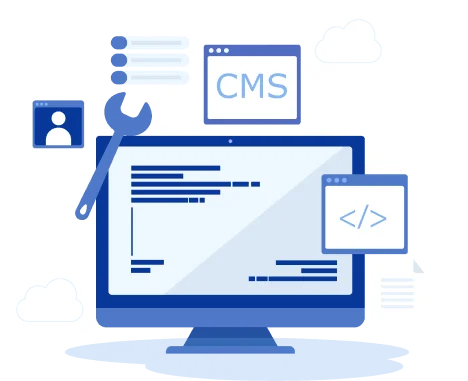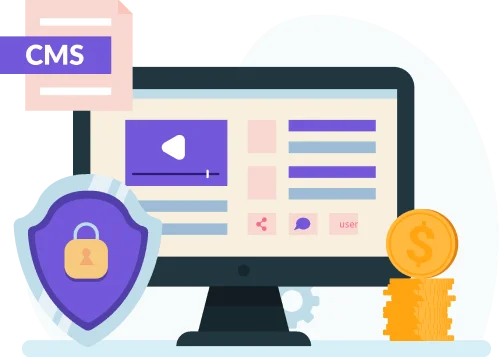Headless CMS
a quick glance
Headless CMS – a quick glance
Headless CMSs are becoming extremely popular as organizations look for ways to create more engaging experiences for their customers nowadays. Because a headless CMS allows content creators to focus on creating high-quality content without having to worry about the technical aspects of web development. Using a headless CMS, content creators can quickly and easily publish their content to any channel, device, or interface. Additionally, headless CMSs are often more cost-effective than traditional content management systems, allowing businesses to invest more in content creation.
The headless CMS software market was valued at $328.5 million in 2019, and it is projected to reach $1628.6 million by 2027, with an expected CAGR of 22.6% from 2020 to 2027.
– The Insights Partner

Headless CMS
Technically, a headless CMS is a content management system (CMS) that is built and managed without any front-end or presentation layer. In other words, a headless CMS is a content management system that separates the front end of a website from its back end, allowing content creators to manage and deliver content to any type of device. It provides a headless architecture, where content is stored in a database and can be accessed via an API. This allows for decoupled content management, where the content can be used across multiple channels and platforms.
Traditional vs. Headless CMS
Comparing it with traditional CMS, Headless CMS is superior in a variety of ways. Firstly, headless CMS has greater flexibility, allowing the content to be used in a variety of different channels, such as the web, mobile, and IoT devices. Secondly, a headless CMS is more cost-effective, since it does not require the use of a front-end interface. Thirdly, it is easier to integrate with other applications and platforms, allowing for more rapid development and customization. Finally, it is more secure, since the content is not exposed to the public.
Benefits of using Headless CMS
Headless CMS offers many benefits over traditional CMS systems, as follows
 Flexibility
Flexibility
The primary benefit of a headless CMS is its flexibility. Headless CMS gives developers more control over how content is presented and used. Because in a traditional CMS, content is tied to a specific template or page, preventing it from being easily repurposed. But in a headless CMS, content is stored independently of any particular template or page, allowing it to be used in a variety of ways. This makes it easier to create and manage content for a variety of applications, from single-page web apps to mobile apps to connected devices. Otherwise, in a headless CMS, the content management system is decoupled from the front end, allowing developers to create custom interfaces and experiences for different channels and devices.
 Scalability
Scalability
Headless CMS systems offer more secure content delivery, by separating the backend from the frontend. The CMS is less vulnerable to attacks here because the backend is not exposed to the public internet. This makes it much more difficult for malicious actors to gain access to the CMS, keeping content safe.
 Security
Security
These organizations can also use the cloud to educate and train their staff members. Compared to a traditional LMS, a cloud-based LMS has several advantages in terms of how easily staff members may develop course content, upload materials, and deliver courses customized for their particular department or location. Furthermore, it encourages users to offer support and get feedback, and progress can be easily tracked to verify that learning objectives are achieved.

 Agility
Agility
Headless CMS systems are more agile than traditional CMS systems, as they allow developers to quickly create, update, and deploy new features and applications.
 Improved performance
Improved performance
By offloading content delivery to a separate service, the CMS itself becomes lighter and faster. This can result in improved page load times and better overall performance.
 Cost-effectiveness
Cost-effectiveness
Headless CMS systems are typically much more cost effective than traditional CMS systems, as they require less upfront investment and can be scaled as needed.
Who needs a headless CMS?
Headless CMSs are a great option for companies in a variety of industries, from retail and e-commerce to media, entertainment, travel, and also non-profits. They provide the flexibility to quickly create modern, content-rich websites and applications with lots of dynamic features, such as interactive charts, maps, and videos, without having to customize the underlying code. Additionally, they offer a great way to manage and deliver content across multiple platforms and devices. With a headless CMS, organizations can create a unified experience for customers, no matter how they access their content. They also benefit from the ability to make content updates with ease, ensuring that their customers have the most up-to-date information.
Main use cases for headless CMS
 Content Distribution
Content Distribution
Headless CMS can be used to distribute content across multiple channels, such as websites, mobile apps, and even physical kiosks. This is especially useful for larger companies that need to reach a wide variety of audiences.
 Content Aggregation
Content Aggregation
Headless CMS can be used to aggregate content from different sources, such as social media, blogs, and third-party websites. This allows companies to create a comprehensive view of their content across all channels.
 API-driven Development
API-driven Development
Headless CMS can be used to quickly and easily develop APIs that facilitate the integration of the CMS with other systems. This makes it easier to build more complex applications, such as e-commerce stores or marketing automation tools.
 Personalization
Personalization
Headless CMS can be used to create personalized experiences for users based on their preferences or past behavior. This can be used to create more targeted and effective marketing campaigns.
 Data Management
Data Management
Headless CMS can be used to store and manage large amounts of data, such as customer profiles or transactions. This data can be used for analytics and performance tracking.
Above all, cost-effectiveness is a crucial feature when it comes to choosing a CMS. It depends on the specific needs and demands of your company. But in general, when it comes to cost-effective headless CMS implementation, Umbraco Heartcore is a great option. In the process, Changepond’s CMS experts can help you in various ways, such as setting up a content model, creating content types and templates, integrating different platforms and services, and setting up a content workflow. They can also help you with the overall design and architecture of your website, ensuring that it is optimized for performance, scalability, and security. Additionally, our CMS experts can provide support and guidance on how to make the most of your headless CMS implementation.
